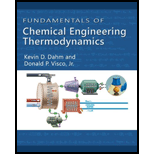
(A)
Interpretation:
The efficiency of the compressor.
Concept Introduction:
The entropy balance around the reversible compressor is,
Here, number of moles in the system is N, specific entropy of the system is
The molar entropy difference across the compressor modeling the gas as ideal is,
Here, heat capacity at constant pressure and constant volume for an ideal gas condition is
The expression of the enthalpy of effluent of the reversible compressor is,
Here, change in molar enthalpy is
The entropy balance equation around the reversible compressor is,
Here, time is t, number of moles in the system is N, molar internal energy of the system is
The expression of compressor efficiency is,
Here, work done on the shaft by reversible process is
(A)
Explanation of Solution
Given information:
Specific heat at constant volume is
Write an entropy balance around the reversible compressor.
Rewrite Equation (1) for an entropy balance equation for an adiabatic, steady state turbine with only one stream entering and leaving the system.
At steady state
Rewrite Equation (2).
Write the molar entropy difference across the compressor modeling the gas as ideal.
Substitute 14R for
Simply for
Write the expression of the enthalpy of effluent of the reversible compressor.
Substitute 299.1 K for
Write the entropy balance around the reversible compressor.
At steady state, the accumulation term is 0, and the time independent energy balance simplifies.
Rewrite Equation (6).
Here, there is only one material stream entering and leaving the system.
Rewrite Equation (7).
Substitute
Substitute
Write the energy balance around the actual compressor.
The accumulation term is 0at steady state and hence,
Neglect the terms and rewrite Equation (9).
Here, there is only one material stream entering and leaving the system.
Rewrite Equation (10).
Substitute
Write the expression of compressor efficiency.
Substitute
Thus, the efficiency of compressor is
(B)
Interpretation:
The required flow rate of the refrigerant.
Concept Introduction:
The expression to obtain the required flow rate of the refrigerant is,
Here, cooling rate is
(B)
Explanation of Solution
Write the energy balance around the boiler.
The accumulation term is 0at steady state and hence,
Neglect the terms and rewrite Equation (13).
Here, there is only one material stream entering and leaving the system.
Rewrite Equation (14).
Substitute
Write the expression to obtain the required flow rate of the refrigerant.
Substitute
Thus, the required flow rate of the refrigerant is
(C)
Interpretation:
The coefficient of performance of the refrigeration cycle.
Concept Introduction:
The expression to obtain the coefficient of performance of the refrigeration cycle is,
(C)
Explanation of Solution
Write the expression to obtain the coefficient of performance of the refrigeration cycle.
Substitute
Thus, the coefficient of performance of the refrigeration cycle is
(D)
Interpretation:
Design a refrigeration cycle using R-134a as the refrigerant.
Concept Introduction:
The energy balance around the reversible compressor is,
Here, mass flow rate is
The expression for compressor efficiency is,
Here, work done on the shaft by reversible process is
The energy balance on the boiler is,
Here, time is t, total mass of the system is M, specific internal energy of the system is
The expression to obtain the coefficient of performance of the refrigeration cycle is,
(D)
Explanation of Solution
Assume the condenser and boiler temperatures are the same.
Write the entropy balance around the reversible compressor.
Refer Appendix F, “
Condenser operates at 50°C = 122°F so the compressor outlet pressure must equal vapor pressure at this temperature, which according to the figure is slightly below 200 psia.
Write the energy balance around the reversible compressor.
Refer Appendix F, “Thermodynamic diagrams of pressure-enthalpy”, obtain the specific enthalpy for inlet state at saturated vapor R-422A at
Obtain the specific enthalpy of the outlet by following the line of constant entropy from the inlet condition to pressure of 195 psiaas
Substitute
Write the compressor efficiency.
Substitute 0.468 for
Write the energy balance on the boiler.
The accumulation term is 0at steady state and hence,
Neglect the terms and rewrite Equation (21).
Here, there is only one material stream entering and leaving the system, and
Rewrite Equation (22).
Refer Appendix F, “Thermodynamic diagrams of pressure-enthalpy”, obtain the specific enthalpy for outlet state at saturated vapor R-422A at
Refer Appendix F, “Thermodynamic diagrams of pressure-enthalpy”, obtain the specific enthalpy for inlet state at saturated liquid of
Substitute
Write the expression to obtain the coefficient of performance of the refrigeration cycle.
Substitute
Thus, the coefficient of performance of the refrigeration cycle is
(E)
Interpretation:
Comment on the inventor’s claim that the proprietary refrigerant is better than R-134a.
(E)
Explanation of Solution
The inventor’s refrigerant is good when compared to the COP of each cycle. But neither COP is extremely large as the inventor’s system has compressor efficiency of less than 50%.
Want to see more full solutions like this?
Chapter 5 Solutions
Fundamentals of Chemical Engineering Thermodynamics (MindTap Course List)
 Introduction to Chemical Engineering Thermodynami...Chemical EngineeringISBN:9781259696527Author:J.M. Smith Termodinamica en ingenieria quimica, Hendrick C Van Ness, Michael Abbott, Mark SwihartPublisher:McGraw-Hill Education
Introduction to Chemical Engineering Thermodynami...Chemical EngineeringISBN:9781259696527Author:J.M. Smith Termodinamica en ingenieria quimica, Hendrick C Van Ness, Michael Abbott, Mark SwihartPublisher:McGraw-Hill Education Elementary Principles of Chemical Processes, Bind...Chemical EngineeringISBN:9781118431221Author:Richard M. Felder, Ronald W. Rousseau, Lisa G. BullardPublisher:WILEY
Elementary Principles of Chemical Processes, Bind...Chemical EngineeringISBN:9781118431221Author:Richard M. Felder, Ronald W. Rousseau, Lisa G. BullardPublisher:WILEY Elements of Chemical Reaction Engineering (5th Ed...Chemical EngineeringISBN:9780133887518Author:H. Scott FoglerPublisher:Prentice Hall
Elements of Chemical Reaction Engineering (5th Ed...Chemical EngineeringISBN:9780133887518Author:H. Scott FoglerPublisher:Prentice Hall
 Industrial Plastics: Theory and ApplicationsChemical EngineeringISBN:9781285061238Author:Lokensgard, ErikPublisher:Delmar Cengage Learning
Industrial Plastics: Theory and ApplicationsChemical EngineeringISBN:9781285061238Author:Lokensgard, ErikPublisher:Delmar Cengage Learning Unit Operations of Chemical EngineeringChemical EngineeringISBN:9780072848236Author:Warren McCabe, Julian C. Smith, Peter HarriottPublisher:McGraw-Hill Companies, The
Unit Operations of Chemical EngineeringChemical EngineeringISBN:9780072848236Author:Warren McCabe, Julian C. Smith, Peter HarriottPublisher:McGraw-Hill Companies, The





